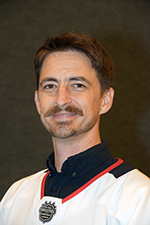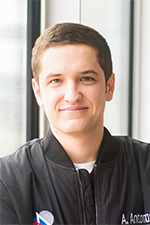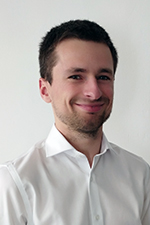2024 Phelps Award Winners

The 2024 Paul Phelps Continuing Education Grant was awarded to three student members from the radiation effects community. At the opening of the NSREC Conference (July 22nd, 2024), Robert Reed, Chair of the Radiation Effects Steering Group, announced the grant awards. The grants included tuition for the 2024 NSREC Short Course and a check for $1000.
The purpose of the Phelps Grant is to promote continuing education and encourage membership in the Nuclear and Plasma Sciences Society (NPSS). The criteria for judging are exceptional promise as a student, postdoc or research associate in any of the fields of NPSS, or exceptional work in those fields by currently unemployed NPSS members with an expectation that attendance at the Short Course will improve the possibility of obtaining a job in an NPSS field.
The three recipients of the 2024 Paul Phelps Continuing Education Grant were Aubin Antonsanti, Fiammetta Fricano, and Martin Roche.



Aubin Antonsanti, a Ph.D. student at ISAE-SUPAERO, Université de Toulouse, France, in collaboration with CNES and NASA, is pursuing his degree in the field of radiation effects on advanced solid state image sensors with a focus on CMOS image sensors. He graduated with a Master’s in Electrical Engineering from the National Institute of Applied Science of Lyon (INSA Lyon) in 2020 with a double degree in Nuclear Engineering from the National Institute for Nuclear Sciences (INSTN) in the same year.
His Ph.D. research focuses on the effects of radiation on image sensors for space applications, particularly on small pitch sensors, atomic displacement damage, ionizing dose, and Random Telegraph Signal (RTS). Throughout his Ph.D. Aubin joined NASA Goddard Space Flight Center’s Radiation Effects and Analysis Group (REAG) where he worked as a Research Assistant. During his one-year stay, he conducted several irradiation test campaigns and notably investigated RTS within H4RG-10 HgCdTe infrared detectors as part of the qualification testing for the Roman Space Telescope Wide Field Instrument sensor chip assembly.
Aubin has published several papers in IEEE Transactions on Nuclear Science and has presented his research at major IEEE conferences including RADECS and NSREC. He received the Jean-Marie Palau Award for the best student presentation at RADECS 2022, Venice, and his work was also part of NASA Goddard Space Flight Center’s Current Radiation Effects Test Results that was awarded the Outstanding Data Workshop Presentation at NSREC 2023.
Aubin is dedicated to science communication, regularly participating in open days and educational events to popularize science among the youth and the public. As vice chair of the ISAE-SUPAERO IEEE Student Branch, he has organized numerous experts talks, contributing to the organization of IEEE-sponsored international conferences like EEDAL 2022 and RADECS 2023.
Fiammetta Fricano is a 2020 Physics graduate of University of Palermo (Italy). After doing her master internship in Spring 2021 on radiation effects on optical fiber-based dosimetry within the Laboratoire Hubert Curien’s MOPERE team (Materials for Optics and Photonics in Extreme Radiation Environment), Fiammetta remained in the same team to work on her Ph.D. under the supervision of Prof. Aziz Boukenter. She is studying the luminescence induced by radiation on several types of optical fibers, in order to develop a radiation dosimeter for medicine applications. During her Ph.D., Fiammetta authored and co-authored no less than eight publications in scientific journals. An active member of IEEE NPSS, she serves as the vice president of the IEEE Saint-Etienne student branch.
Martin Roche is a Ph.D. student who is currently in the final stages of writing his dissertation, with plans to submit it at the end of the year. In 2021, he obtained his double master’s degree from Jean Monnet University and the Telecom Saint-Etienne engineering school in Saint-Etienne, France. During his Master’s thesis at Airbus Defence and Space, Martin worked in partnership with the MOPERE team (Materials for Optics and Photonics in Extreme Radiation Environment) at the Hubert Curien Laboratory. During his Master’s Thesis, he worked on optical fibers and their behavior in space environments, particularly for telecommunication challenges with high-power laser sources. Highly interested in this topic, Martin decided to continue his studies with a Ph.D. Thesis at CNES (Centre National d’Études Spatiales), co-funded by Exail company, and still in partnership with the MOPERE team. Supervised by Prof. Sylvain Girard, Martin’s research focuses on the influence and measurement of space ionizing radiations with optical fibers. He actively participated in the LUMINA project, a famous optical fiber-based dosimeter sent to the International Space Station in 2021 and still operational today. During his doctoral studies, Martin has authored and co-authored no fewer than seven publications in IEEE journals and participated in numerous international conferences, including RADECS and NSREC conferences. His primary purpose is to advance the field of dosimetry and telecommunications in space environments. Martin also successfully presided over the IEEE student branch and NPSS chapter of Saint-Etienne, with the primary aim of popularizing science among the general public and young students. As an avid botanist, he has constantly transformed his office into an increasingly flourishing jungle, perhaps to the despair of his colleagues.
Michael Campola, NSREC 2025 Vice-Chair of Publicity, can be reached by E-mail at [email protected]